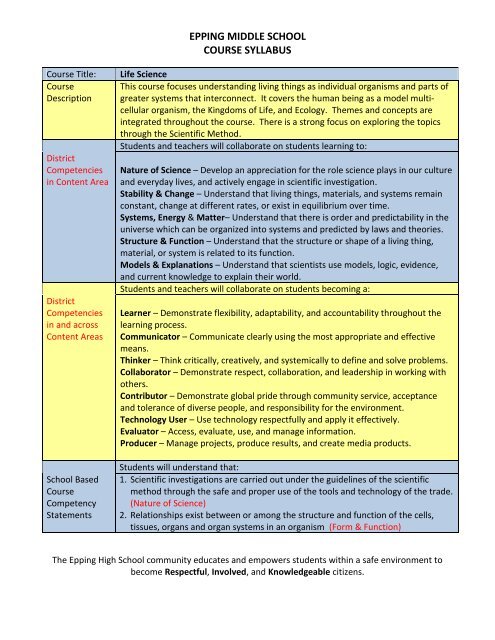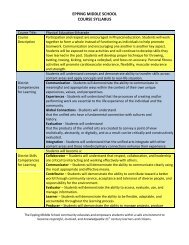Grade 7 Science Curriculum - SAU 14
Grade 7 Science Curriculum - SAU 14
Grade 7 Science Curriculum - SAU 14
- No tags were found...
Create successful ePaper yourself
Turn your PDF publications into a flip-book with our unique Google optimized e-Paper software.
EPPING MIDDLE SCHOOLCOURSE SYLLABUSCourse Title:CourseDescriptionDistrictCompetenciesin Content AreaDistrictCompetenciesin and acrossContent AreasSchool BasedCourseCompetencyStatementsLife <strong>Science</strong>This course focuses understanding living things as individual organisms and parts ofgreater systems that interconnect. It covers the human being as a model multicellularorganism, the Kingdoms of Life, and Ecology. Themes and concepts areintegrated throughout the course. There is a strong focus on exploring the topicsthrough the Scientific Method.Students and teachers will collaborate on students learning to:Nature of <strong>Science</strong> – Develop an appreciation for the role science plays in our cultureand everyday lives, and actively engage in scientific investigation.Stability & Change – Understand that living things, materials, and systems remainconstant, change at different rates, or exist in equilibrium over time.Systems, Energy & Matter– Understand that there is order and predictability in theuniverse which can be organized into systems and predicted by laws and theories.Structure & Function – Understand that the structure or shape of a living thing,material, or system is related to its function.Models & Explanations – Understand that scientists use models, logic, evidence,and current knowledge to explain their world.Students and teachers will collaborate on students becoming a:Learner – Demonstrate flexibility, adaptability, and accountability throughout thelearning process.Communicator – Communicate clearly using the most appropriate and effectivemeans.Thinker – Think critically, creatively, and systemically to define and solve problems.Collaborator – Demonstrate respect, collaboration, and leadership in working withothers.Contributor – Demonstrate global pride through community service, acceptanceand tolerance of diverse people, and responsibility for the environment.Technology User – Use technology respectfully and apply it effectively.Evaluator – Access, evaluate, use, and manage information.Producer – Manage projects, produce results, and create media products.Students will understand that:1. Scientific investigations are carried out under the guidelines of the scientificmethod through the safe and proper use of the tools and technology of the trade.(Nature of <strong>Science</strong>)2. Relationships exist between or among the structure and function of the cells,tissues, organs and organ systems in an organism (Form & Function)The Epping High School community educates and empowers students within a safe environment tobecome Respectful, Involved, and Knowledgeable citizens.
EPPING MIDDLE SCHOOLCOURSE SYLLABUS(Need to beassessed usingNHDOEvalidationrubric)(* no more than8)Course UnitContent andSkills(Aligncompetenciesto units)3. Genetic information is handed down from both parents to offspring. (Constancy& Change)4. Organisms are classified into a system of kingdoms according to their degree ofevolutionary relatedness. (Form & Function, Systems & Energy)5. Relationships exist among groups of organism that can be illustrated, comparedand interpreted. (Constancy & Change)6. Certain traits of organisms may provide a survival advantage in a specificenvironment. (Constancy & Change)7. Matter and energy flow through and between ecosystems following patterns thatinclude both living and non-living factors. (Systems & Energy)8. Scientific knowledge is the result of the cumulative efforts of people, past andpresent, who have attempted to understand the natural world, and that thisknowledge is continually revised as new information is obtained. (Models &Explanations)Students will be able to:Characteristics of Life Conduct an investigation to provide evidence that living things are madeof cells; either one cell or many different numbers and types of cells.(Systems, Energy, & Matter) Develop and use a model to describe the function of a cell as a whole andways parts of cells contribute to the function. (Models & Explanations)Ecology Analyze and interpret data to provide evidence for the effects of resourceavailability on organisms and populations of organisms in an ecosystem.(Systems, Energy, & Matter) Construct an explanation that predicts patterns of interactions amongorganisms across multiple ecosystems. (Stability & Change) Develop a model to describe the cycling of matter and flow of energyamong living and nonliving parts of an ecosystem. (Systems, Energy, &Matter)Construct an argument supported by empirical evidence that changes tophysical or biological components of an ecosystem affect populations.(Stability & Change)Evaluate competing design solutions for maintaining biodiversity andecosystem services. (Nature of <strong>Science</strong>)Define the criteria and constraints of a design problem with sufficientThe Epping High School community educates and empowers students within a safe environment tobecome Respectful, Involved, and Knowledgeable citizens.
EPPING MIDDLE SCHOOLCOURSE SYLLABUSprecision to ensure a successful solution, taking into account relevantscientific principles and potential impacts on people and the naturalenvironment that may limit possible solutions. (Nature of <strong>Science</strong>)Anatomy and Physiology Use argument supported by evidence for how the body is a system ofinteracting subsystems composed of groups of cells. (Systems, Energy, &Matter) Develop a model to describe how food is rearranged through chemicalreactions forming new molecules that support growth and/or releaseenergy as this matter moves through an organism. (Stability & Change) Gather and synthesis information that sensory receptors respond tostimuli by sending messages to the brain for immediate behavior orstorage as memories. (Structure & Function) Develop a model to generate data for iterative testing and modification ofa proposed object, tool, or process such that an optimal design can beachieved. (Nature of <strong>Science</strong>)Botany Use argument, based on empirical evidence and scientific reasoning, tosupport an explanation for how characteristic plant structures affect theprobability of successful reproduction of plants. (Structure & Function)Construct a scientific explanation based on evidence for howenvironmental and genetic factors influence the growth of organisms.(Models & Explanations)Construct a scientific explanation based on evidence for the role ofphotosynthesis in the cycling of matter and flow of energy into and out oforganisms. (Models & Explanations)Analyze data from tests to determine similarities and differences amongseveral design solutions to identify the best characteristics of each thatcan be combined into a new solution to better meet the criteria forsuccess. (Nature of <strong>Science</strong>)Zoology Analyze and interpret data for patterns in the fossil record that documentthe existence, diversity, extinction, and change of life forms throughoutthe history of life on Earth under the assumption that natural lawsThe Epping High School community educates and empowers students within a safe environment tobecome Respectful, Involved, and Knowledgeable citizens.
EPPING MIDDLE SCHOOLCOURSE SYLLABUSoperate today as in the past. (System, Energy & Matter)Describe how different organisms: obtain energy, grow, move, respond,provide defense, enable reproduction and maintain internal balance.(Structure & Function)Analyze displays of pictorial data to compare patterns of similarities in theembryological development across multiple species to identifyrelationships not evident in the fully formed anatomy. (Models &Explanation)Apply scientific ideas to construct an explanation for the anatomicalsimilarities and differences among modern organisms and betweenmodern and fossil organisms to infer evolutionary relationships. (Models& Explanations)Use argument, based on empirical evidence and scientific reasoning, tosupport an explanation for how characteristic animal behaviors affect theprobability of successful reproduction of animals. (Models & Explanations)Evaluate competing design solutions using a systematic process todetermine how well they meet the criteria and constraints of theproblem. (Nature of <strong>Science</strong>)Genetics Develop and use a model to describe why structural changes to genes(mutations) located on chromosomes may affect proteins and my result inharmful, beneficial, or neutral effects to the structure and function of theorganism. (Models & Explanations)Develop and use a model to describe why asexual reproduction results inoffspring with identical information and sexual reproduction results inoffspring with genetic variation. (Models & Explanations)Construct an explanation based on evidence that describes how geneticvariations of traits in a population increase some individuals’ probabilityof surviving and reproducing in a specific environment. (Models &Explanations)Gather and synthesize information about the technologies that havechanged the way humans influence the inheritance of desired traits inorganisms. (Nature of <strong>Science</strong>)The Epping High School community educates and empowers students within a safe environment tobecome Respectful, Involved, and Knowledgeable citizens.
EPPING MIDDLE SCHOOLCOURSE SYLLABUSUse mathematical representations to support explanations of how naturalselection may lead to increases and decreases of specific traits inpopulations over time. (Models & Explanations)InstructionalStrategies(Cleararticulation ofinstructionalstrategies)1. Making ConnectionsConnecting to prior knowledge and experience2. VisualizingCreating physical models, diagramming & mapping, using imagination3. Asking QuestionsDeveloping the research question, wondering about, asking who, what, when,where & why.4. Making InferencesFilling in missing information, hypothesizing, making predictions5. SynthesizingUse data to develop deeper meaning, generating new ideas from the information6. Determining ImportanceIdentifying what was learned, finding the main idea & supporting ideas. I7. Knowing What Strategy Works.Identifying the strategies used, awareness of personal strengths and weaknesses.AssessmentStrategies(Cleararticulation ofassessmentstrategies)Formative Assessments (Entrance/Exit Passes, Lab Rough Drafts, ScientificNotebooks, Classwork, Quizzes)Summative Assessments (Lab Final Drafts/Student Lab Portfolios,Projects/Presentations, Scenarios/Tests)Approved DRAFT June 5, 2012Revised June, 2013 – Incorporated NGSSThe Epping High School community educates and empowers students within a safe environment tobecome Respectful, Involved, and Knowledgeable citizens.
















